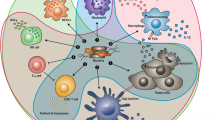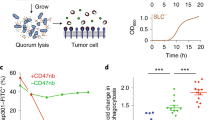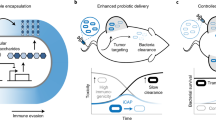Abstract
Several bacterial species have inherent ability to colonize solid tumors in vivo. However, their natural anti-tumor activity can be enhanced by genetic engineering that enables these bacteria express or transfer therapeutic molecules into target cells. In this review, we summarize latest research on cancer therapy using genetically modified bacteria with particular emphasis on blocking tumor angiogenesis. Despite recent progress, only a few recent studies on bacterial tumor therapy have focused on anti-angiogenesis. Bacteria-mediated anti-angiogenesis therapy for cancer, however, is an attractive approach given that solid tumors are often characterized by increased vascularization. Here, we discuss four different approaches for using modified bacteria as anti-cancer therapeutics—bactofection, DNA vaccination, alternative gene therapy and transkingdom RNA interference—with a specific focus on angiogenesis suppression. Critical areas and future directions for this field are also outlined.
This is a preview of subscription content, access via your institution
Access options
Subscribe to this journal
Receive 12 print issues and online access
$259.00 per year
only $21.58 per issue
Buy this article
- Purchase on Springer Link
- Instant access to full article PDF
Prices may be subject to local taxes which are calculated during checkout

Similar content being viewed by others
References
Moese JR, Moese G . Oncolysis by Clostridia I. Activity of Clostridium Butyricum (M-55) and other nonpathogenic Clostridia against the ehrlich carcinoma. Cancer Res 1964; 24: 212–216.
Zheng LM, Luo X, Feng M, Li Z, Le T, Ittensohn M et al. Tumor amplified protein expression therapy: Salmonella as a tumor-selective protein delivery vector. Oncol Res 2000; 12: 127–135.
Yazawa K, Fujimori M, Amano J, Kano Y, Taniguchi S . Bifidobacterium longum as a delivery system for cancer gene therapy: selective localization and growth in hypoxic tumors. Cancer Gene Ther 2000; 7: 269–274.
Theys J, Landuyt AW, Nuyts S, Van Mellaert L, Lambin P, Anne J . Clostridium as a tumor-specific delivery system of therapeutic proteins. Cancer Detect Prev 2001; 25: 548–557.
Wei MQ, Ellem KA, Dunn P, West MJ, Bai CX, Vogelstein B . Facultative or obligate anaerobic bacteria have the potential for multimodality therapy of solid tumours. Eur J Cancer 2007; 43: 490–496.
Westphal K, Leschner S, Jablonska J, Loessner H, Weiss S . Containment of tumor-colonizing bacteria by host neutrophils. Cancer Res 2008; 68: 2952–2960.
Pawelek JM, Low KB, Bermudes D . Bacteria as tumour-targeting vectors. Lancet Oncol 2003; 4: 548–556.
Wei MQ, Mengesha A, Good D, Anne J . Bacterial targeted tumour therapy-dawn of a new era. Cancer Lett 2008; 259: 16–27.
Seow Y, Wood MJ . Biological gene delivery vehicles: beyond viral vectors. Mol Ther 2009; 17: 767–777.
Hayashi K, Zhao M, Yamauchi K, Yamamoto N, Tsuchiya H, Tomita K et al. Cancer metastasis directly eradicated by targeted therapy with a modified Salmonella typhimurium. J Cell Biochem 2009; 106: 992–998.
Hayashi K, Zhao M, Yamauchi K, Yamamoto N, Tsuchiya H, Tomita K et al. Systemic targeting of primary bone tumor and lung metastasis of high-grade osteosarcoma in nude mice with a tumor-selective strain of Salmonella typhimurium. Cell Cycle 2009; 8: 870–875.
King I, Bermudes D, Lin S, Belcourt M, Pike J, Troy K et al. Tumor-targeted Salmonella expressing cytosine deaminase as an anticancer agent. Hum Gene Ther 2002; 13: 1225–1233.
Friedlos F, Lehouritis P, Ogilvie L, Hedley D, Davies L, Bermudes D et al. Attenuated Salmonella targets prodrug activating enzyme carboxypeptidase G2 to mouse melanoma and human breast and colon carcinomas for effective suicide gene therapy. Clin Cancer Res 2008; 14: 4259–4266.
Cheng CM, Lu YL, Chuang KH, Hung WC, Shiea J, Su YC et al. Tumor-targeting prodrug-activating bacteria for cancer therapy. Cancer Gene Ther 2008; 15: 393–401.
Chen G, Wei DP, Jia LJ, Tang B, Shu L, Zhang K et al. Oral delivery of tumor-targeting Salmonella exhibits promising therapeutic efficacy and low toxicity. Cancer Sci 2009; 100: 2437–2443.
Maciag PC, Radulovic S, Rothman J . The first clinical use of a live-attenuated listeria monocytogenes vaccine: a phase I safety study of Lm-LLO-E7 in patients with advanced carcinoma of the cervix. Vaccine 2009; 27: 3975–3983.
Xiang S, Fruehauf J, Li CJ . Short hairpin RNA-expressing bacteria elicit RNA interference in mammals. Nat Biotechnol 2006; 24: 697–702.
Alexandroff AB, Nicholson S, Patel PM, Jackson AM . Recent advances in bacillus Calmette-Guerin immunotherapy in bladder cancer. Immunotherapy 2010; 2: 551–560.
Agrawal N, Bettegowda C, Cheong I, Geschwind JF, Drake CG, Hipkiss EL et al. Bacteriolytic therapy can generate a potent immune response against experimental tumors. Proc Natl Acad Sci USA 2004; 101: 15172–15177.
Zhou S . Combination therapy with bacteria and angiogenesis inhibitors: strangling cancer without mercy. Cancer Biol Ther 2005; 4: 846–847.
Jia LJ, Xu HM, Ma DY, Hu QG, Huang XF, Jiang WH et al. Enhanced therapeutic effect by combination of tumor-targeting Salmonella and endostatin in murine melanoma model. Cancer Biol Ther 2005; 4: 840–845.
Lee CH, Wu CL, Shiau AL . Endostatin gene therapy delivered by Salmonella choleraesuis in murine tumor models. J Gene Med 2004; 6: 1382–1393.
Yuhua L, Kunyuan G, Hui C, Yongmei X, Chaoyang S, Xun T et al. Oral cytokine gene therapy against murine tumor using attenuated Salmonella typhimurium. Int J Cancer 2001; 94: 438–443.
Agorio C, Schreiber F, Sheppard M, Mastroeni P, Fernandez M, Martinez MA et al. Live attenuated Salmonella as a vector for oral cytokine gene therapy in melanoma. J Gene Med 2007; 9: 416–423.
Yoon WS, Choi WC, Sin JI, Park YK . Antitumor therapeutic effects of Salmonella typhimurium containing Flt3 Ligand expression plasmids in melanoma-bearing mouse. Biotechnol Lett 2007; 29: 511–516.
Lee CH, Wu CL, Shiau AL . Systemic administration of attenuated Salmonella choleraesuis carrying thrombospondin-1 gene leads to tumor-specific transgene expression, delayed tumor growth and prolonged survival in the murine melanoma model. Cancer Gene Ther 2005; 12: 175–184.
Castagliuolo I, Beggiao E, Brun P, Barzon L, Goussard S, Manganelli R et al. Engineered E. coli delivers therapeutic genes to the colonic mucosa. Gene Therapy 2005; 12: 1070–1078.
Larsen MD, Griesenbach U, Goussard S, Gruenert DC, Geddes DM, Scheule RK et al. Bactofection of lung epithelial cells in vitro and in vivo using a genetically modified Escherichia coli. Gene Therapy 2008; 15: 434–442.
Xiang R, Lode HN, Chao TH, Ruehlmann JM, Dolman CS, Rodriguez F et al. An autologous oral DNA vaccine protects against murine melanoma. Proc Natl Acad Sci USA 2000; 97: 5492–5497.
Niethammer AG, Xiang R, Becker JC, Wodrich H, Pertl U, Karsten G et al. A DNA vaccine against VEGF receptor 2 prevents effective angiogenesis and inhibits tumor growth. Nat Med 2002; 8: 1369–1375.
Kim B, Suvas S, Sarangi PP, Lee S, Reisfeld RA, Rouse BT . Vascular endothelial growth factor receptor 2-based DNA immunization delays development of herpetic stromal keratitis by antiangiogenic effects. J Immunol 2006; 177: 4122–4131.
Hauer AD, van Puijvelde GH, Peterse N, de Vos P, van Weel V, van Wanrooij EJ et al. Vaccination against VEGFR2 attenuates initiation and progression of atherosclerosis. Arterioscler Thromb Vasc Biol 2007; 27: 2050–2057.
Petrovan RJ, Kaplan CD, Reisfeld RA, Curtiss LK . DNA vaccination against VEGF receptor 2 reduces atherosclerosis in LDL receptor-deficient mice. Arterioscler Thromb Vasc Biol 2007; 27: 1095–1100.
Lu XL, Jiang XB, Liu RE, Zhang SM . The enhanced anti-angiogenic and antitumor effects of combining flk1-based DNA vaccine and IP-10. Vaccine 2008; 26: 5352–5357.
Luo Y, Zhou H, Mizutani M, Mizutani N, Reisfeld RA, Xiang R . Transcription factor Fos-related antigen 1 is an effective target for a breast cancer vaccine. Proc Natl Acad Sci USA 2003; 100: 8850–8855.
Xiang R, Mizutani N, Luo Y, Chiodoni C, Zhou H, Mizutani M et al. A DNA vaccine targeting survivin combines apoptosis with suppression of angiogenesis in lung tumor eradication. Cancer Res 2005; 65: 553–561.
Lee SH, Mizutani N, Mizutani M, Luo Y, Zhou H, Kaplan C et al. Endoglin (CD105) is a target for an oral DNA vaccine against breast cancer. Cancer Immunol Immunother 2006; 55: 1565–1574.
Epaulard O, Toussaint B, Quenee L, Derouazi M, Bosco N, Villiers C et al. Anti-tumor immunotherapy via antigen delivery from a live attenuated genetically engineered Pseudomonas aeruginosa type III secretion system-based vector. Mol Ther 2006; 14: 656–661.
Xiang R, Luo Y, Niethammer AG, Reisfeld RA . Oral DNA vaccines target the tumor vasculature and microenvironment and suppress tumor growth and metastasis. Immunol Rev 2008; 222: 117–128.
Palffy R, Gardlik R, Hodosy J, Behuliak M, Resko P, Radvansky J et al. Bacteria in gene therapy: bactofection versus alternative gene therapy. Gene Therapy 2006; 13: 101–105.
Sasaki T, Fujimori M, Hamaji Y, Hama Y, Ito K, Amano J et al. Genetically engineered Bifidobacterium longum for tumor-targeting enzyme-prodrug therapy of autochthonous mammary tumors in rats. Cancer Sci 2006; 97: 649–657.
Schmidt W, Fabricius EM, Schneeweiss U . The tumour-Clostridium phenomenon: 50 years of developmental research (Review). Int J Oncol 2006; 29: 1479–1492.
Wei MQ, Ren R, Good D, Anne J . Clostridial spores as live ‘Trojan horse’ vectors for cancer gene therapy: comparison with viral delivery systems. Genet Vaccines Ther 2008; 6: 8.
Li Z, Fallon J, Mandeli J, Wetmur J, Woo SL . A genetically enhanced anaerobic bacterium for oncopathic therapy of pancreatic cancer. J Natl Cancer Inst 2008; 100: 1389–1400.
Li X, Fu GF, Fan YR, Liu WH, Liu XJ, Wang JJ et al. Bifidobacterium adolescentis as a delivery system of endostatin for cancer gene therapy: selective inhibitor of angiogenesis and hypoxic tumor growth. Cancer Gene Ther 2003; 10: 105–111.
Xu YF, Zhu LP, Hu B, Fu GF, Zhang HY, Wang JJ et al. A new expression plasmid in Bifidobacterium longum as a delivery system of endostatin for cancer gene therapy. Cancer Gene Ther 2007; 14: 151–157.
Fu GF, Li X, Hou YY, Fan YR, Liu WH, Xu GX . Bifidobacterium longum as an oral delivery system of endostatin for gene therapy on solid liver cancer. Cancer Gene Ther 2005; 12: 133–140.
Hu B, Kou L, Li C, Zhu LP, Fan YR, Wu ZW et al. Bifidobacterium longum as a delivery system of TRAIL and endostatin cooperates with chemotherapeutic drugs to inhibit hypoxic tumor growth. Cancer Gene Ther 2009; 16: 655–663.
Loessner H, Endmann A, Leschner S, Westphal K, Rohde M, Miloud T et al. Remote control of tumour-targeted Salmonella enterica serovar Typhimurium by the use of L-arabinose as inducer of bacterial gene expression in vivo. Cell Microbiol 2007; 9: 1529–1537.
Stritzker J, Weibel S, Hill PJ, Oelschlaeger TA, Goebel W, Szalay AA . Tumor-specific colonization, tissue distribution, and gene induction by probiotic Escherichia coli Nissle 1917 in live mice. Int J Med Microbiol 2007; 297: 151–162.
Mengesha A, Dubois L, Lambin P, Landuyt W, Chiu RK, Wouters BG et al. Development of a flexible and potent hypoxia-inducible promoter for tumor-targeted gene expression in attenuated Salmonella. Cancer Biol Ther 2006; 5: 1120–1128.
Ryan RM, Green J, Williams PJ, Tazzyman S, Hunt S, Harmey JH et al. Bacterial delivery of a novel cytolysin to hypoxic areas of solid tumors. Gene Therapy 2009; 16: 329–339.
Arrach N, Zhao M, Porwollik S, Hoffman RM, McClelland M . Salmonella promoters preferentially activated inside tumors. Cancer Res 2008; 68: 4827–4832.
Zhao M, Yang M, Li XM, Jiang P, Baranov E, Li S et al. Tumor-targeting bacterial therapy with amino acid auxotrophs of GFP-expressing Salmonella typhimurium. Proc Natl Acad Sci USA 2005; 102: 755–760.
Stritzker J, Pilgrim S, Szalay AA, Goebel W . Prodrug converting enzyme gene delivery by L. monocytogenes. BMC Cancer 2008; 8: 94.
Loeffler M, Le’Negrate G, Krajewska M, Reed JC . Attenuated Salmonella engineered to produce human cytokine LIGHT inhibit tumor growth. Proc Natl Acad Sci USA 2007; 104: 12879–12883.
Loeffler M, Le’Negrate G, Krajewska M, Reed JC . IL-18-producing Salmonella inhibit tumor growth. Cancer Gene Ther 2008; 15: 787–794.
Loeffler M, Le’Negrate G, Krajewska M, Reed JC . Salmonella typhimurium engineered to produce CCL21 inhibit tumor growth. Cancer Immunol Immunother 2009; 58: 769–775.
Loeffler M, Le’Negrate G, Krajewska M, Reed JC . Inhibition of tumor growth using salmonella expressing Fas ligand. J Natl Cancer Inst 2008; 100: 1113–1116.
al-Ramadi BK, Fernandez-Cabezudo MJ, El-Hasasna H, Al-Salam S, Bashir G, Chouaib S . Potent anti-tumor activity of systemically-administered IL2-expressing Salmonella correlates with decreased angiogenesis and enhanced tumor apoptosis. Clin Immunol 2009; 130: 89–97.
Cunningham C, Nemunaitis J . A phase I trial of genetically modified Salmonella typhimurium expressing cytosine deaminase (TAPET-CD, VNP20029) administered by intratumoral injection in combination with 5-fluorocytosine for patients with advanced or metastatic cancer. Protocol no. CL-017. Version: April 9, 2001. Hum Gene Ther 2001; 12: 1594–1596.
Toso JF, Gill VJ, Hwu P, Marincola FM, Restifo NP, Schwartzentruber DJ et al. Phase I study of the intravenous administration of attenuated Salmonella typhimurium to patients with metastatic melanoma. J Clin Oncol 2002; 20: 142–152.
Nemunaitis J, Cunningham C, Senzer N, Kuhn J, Cramm J, Litz C et al. Pilot trial of genetically modified, attenuated Salmonella expressing the E. coli cytosine deaminase gene in refractory cancer patients. Cancer Gene Ther 2003; 10: 737–744.
Aigner A . Transkingdom RNA interference (tkRNAi) as a new delivery tool for therapeutic RNA. Expert Opin Biol Therapy 2009; 9: 1533–1542.
Zhao HF, L’Abbe D, Jolicoeur N, Wu M, Li Z, Yu Z et al. High-throughput screening of effective siRNAs from RNAi libraries delivered via bacterial invasion. Nat Methods 2005; 2: 967–973.
Jiang Z, Zhao P, Zhou Z, Liu J, Qin L, Wang H . Using attenuated Salmonella typhi as tumor targeting vector for MDR1 siRNA delivery. Cancer Biol Ther 2007; 6: 555–560.
Zhang L, Gao L, Zhao L, Guo B, Ji K, Tian Y et al. Intratumoral delivery and suppression of prostate tumor growth by attenuated Salmonella enterica serovar typhimurium carrying plasmid-based small interfering RNAs. Cancer Res 2007; 67: 5859–5864.
Yang N, Zhu X, Chen L, Li S, Ren D . Oral administration of attenuated S. typhimurium carrying shRNA-expressing vectors as a cancer therapeutic. Cancer Biol Ther 2008; 7: 145–151.
Easwaran V, Lee SH, Inge L, Guo L, Goldbeck C, Garrett E et al. beta-Catenin regulates vascular endothelial growth factor expression in colon cancer. Cancer Res 2003; 63: 3145–3153.
Wei D, Le X, Zheng L, Wang L, Frey JA, Gao AC et al. Stat3 activation regulates the expression of vascular endothelial growth factor and human pancreatic cancer angiogenesis and metastasis. Oncogene 2003; 22: 319–329.
Fernandez A, Udagawa T, Schwesinger C, Beecken W, Achilles-Gerte E, McDonnell T et al. Angiogenic potential of prostate carcinoma cells overexpressing bcl-2. J Natl Cancer Inst 2001; 93: 208–213.
Jia RB, Zhang P, Zhou YX, Song X, Liu HY, Wang LZ et al. VEGF-targeted RNA interference suppresses angiogenesis and tumor growth of retinoblastoma. Ophthalmic Res 2007; 39: 108–115.
Kim WJ, Chang CW, Lee M, Kim SW . Efficient siRNA delivery using water soluble lipopolymer for anti-angiogenic gene therapy. J Control Release 2007; 118: 357–363.
Jiang M, Wang B, Wang C, He B, Fan H, Guo TB et al. Inhibition of hypoxia-inducible factor-1alpha and endothelial progenitor cell differentiation by adenoviral transfer of small interfering RNA in vitro. J Vasc Res 2006; 43: 511–521.
Chetty C, Bhoopathi P, Joseph P, Chittivelu S, Rao JS, Lakka S . Adenovirus-mediated small interfering RNA against matrix metalloproteinase-2 suppresses tumor growth and lung metastasis in mice. Mol Cancer Ther 2006; 5: 2289–2299.
Hadj-Slimane R, Lepelletier Y, Lopez N, Garbay C, Raynaud F . Short interfering RNA (siRNA), a novel therapeutic tool acting on angiogenesis. Biochimie 2007; 89: 1234–1244.
Acknowledgements
The authors are grateful to Andrew Keates, PhD for kindly revising the manuscript. Roman Gardlik is supported by grant of National Scholarship Programme of the Slovak Republic.
Author information
Authors and Affiliations
Corresponding author
Ethics declarations
Competing interests
The authors declare no conflict of interest.
Rights and permissions
About this article
Cite this article
Gardlik, R., Behuliak, M., Palffy, R. et al. Gene therapy for cancer: bacteria-mediated anti-angiogenesis therapy. Gene Ther 18, 425–431 (2011). https://doi.org/10.1038/gt.2010.176
Received:
Revised:
Accepted:
Published:
Issue Date:
DOI: https://doi.org/10.1038/gt.2010.176
Keywords
This article is cited by
-
The role of bacteria in cancer therapy – enemies in the past, but allies at present
Infectious Agents and Cancer (2018)
-
A microfluidic device for studying chemotaxis mechanism of bacterial cancer targeting
Scientific Reports (2018)
-
Therapeutic antitumor potential of endoglin-based DNA vaccine combined with immunomodulatory agents
Gene Therapy (2013)
-
Optimization of Ultrasound-mediated Anti-angiogenic Cancer Gene Therapy
Molecular Therapy - Nucleic Acids (2013)
-
Double-blind, placebo-controlled first in human study to investigate an oral vaccine aimed to elicit an immune reaction against the VEGF-Receptor 2 in patients with stage IV and locally advanced pancreatic cancer
BMC Cancer (2012)



